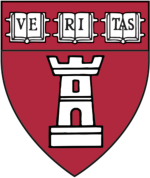Harvard School of Dental Medicine
| Harvard School of Dental Medicine | |
|---|---|

Coat of arms of the School
|
|
| Former names | Harvard Dental School |
| Established | July 17, 1867 |
| Type | Dental school |
| Parent institution | Harvard University |
| Location |
Boston, Massachusetts, United States Coordinates: 42°20′10″N 71°06′08″W / 42.336095°N 71.102126°W |
| Dean | Bruce Donoff |
| Doctoral students | 280 |
| Alumni | 2,300 |
| Website | hsdm |
The Harvard School of Dental Medicine (HSDM) is the dental school of Harvard University. It is located in the Longwood Medical Area in Boston, Massachusetts, United States. In addition to the DMD degree, HSDM offers specialty training programs, advanced training programs, a Ph.D. program through the Harvard Graduate School of Arts and Sciences, and Master of Medical Sciences & Doctor of Medical Sciences degrees through Harvard Medical School. Being highly selective, admission into the pre-doctoral DMD program, as well as into the post-doctoral residency programs, is fiercely competitive. At its heart, the program considers dentistry a specialty of medicine. Therefore, all students at HSDM experience dual citizenship in both Harvard School of Dental Medicine and Harvard Medical School.
Today, HSDM is the smallest school at Harvard University. With a total student body of 280, including pre-doctoral and post-doctoral students spread over several disciplines, HSDM is an intimate community of students and faculty. Even when compared to other dental schools, HSDM is small, and its total living alumni number is approximately 2,500 worldwide and continues to have considerable influence on dental education and research within the broader oral health community. Many other HSDM alumni pursue careers as full-time faculty members, department heads, and leaders of organized dentistry.
In the early 19th century a dentist was culturally understood as a tradesman, as opposed to a professional in the medical sense. Most dentists had either learned their trade through apprenticeships or simply offered their services to the public as self-proclaimed experts.
Even physicians and surgeons had once been tradesmen; for example, in the Middle Ages, many barbers were also surgeons by trade. The advent of science was a principal factor in the professionalization of medicine and surgery, because as scientific knowledge of biology, chemistry, and physiology advanced, it became necessary to be educated academically in order to master the full body of knowledge in medicine; as medicine changed from an art to a mixture of applied science and art, it became something qualitatively different from the folk medicine or traditional medicine that it had earlier been.
...
Wikipedia
